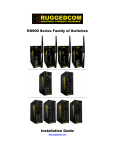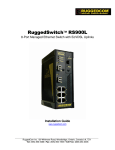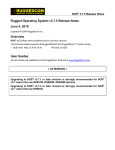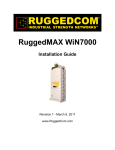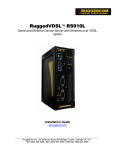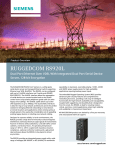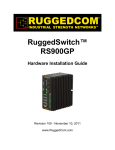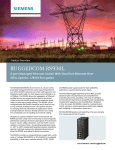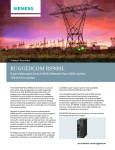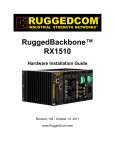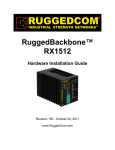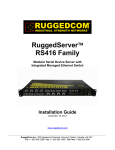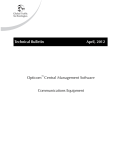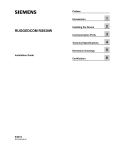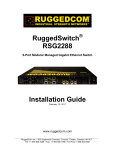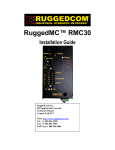Download RuggedSwitch™ RS900 Family - Hardware
Transcript
RuggedSwitch™ RS900 Family Hardware Installation Guide Revision 110 - August 26, 2011 www.RuggedCom.com RuggedSwitch™ RS900 Family RuggedSwitch™ RS900 Family: Hardware Installation Guide Copyright © 2011 RuggedCom Inc. All Rights Reserved Dissemination or reproduction of this document, or evaluation and communication of its contents, is not authorized except where expressly permitted. Violations are liable for damages. All rights are reserved, particularly for the purposes of patent application or trademark registration. This document contains proprietary information, which is protected by copyright. All rights are reserved. No part of this document may be photocopied, reproduced or translated to another language without the prior written consent of RuggedCom Inc. Disclaimer Of Liability We have checked the contents of this manual against the hardware and software described. However, deviations from the description cannot be completely ruled out. RuggedCom shall not be liable for any errors or omissions contained herein or for consequential damages in connection with the furnishing, performance, or use of this material. The information given in this document is reviewed regularly and any necessary corrections will be included in subsequent editions. We appreciate any suggested improvements. We reserve the right to make technical improvements without notice. Registered Trademarks ROX™, RuggedBackbone™, RuggedRated™ and eRSTP™ are trademarks of RuggedCom Inc. ROS®, RuggedRouter® and RuggedSwitch® are registered trademarks of RuggedCom Inc. Other designations in this manual might be trademarks whose use by third parties for their own purposes would infringe the rights of the owner. Linux® is the registered trademark of Linus Torvalds in the U.S. and other countries. The registered trademark Linux® is used pursuant to a sublicense from LMI, the exclusive licensee of Linus Torvalds, owner of the mark on a world-wide basis. Warranty Five (5) years from date of purchase, return to factory. For warranty details, visit www.RuggedCom.com or contact your customer service representative. Contacting RuggedCom Corporate Headquarters US Headquarters Europe Headquarters RuggedCom Inc. 300 Applewood Crescent, Concord, Ontario Canada, L4K 5C7 Tel: +1 905 856 5288 Fax: +1 905 856 1995 Toll-free: 1 888 264 0006 RuggedCom 1930 Harrison Street, Suite 209 Hollywood, Florida USA, 33020 Tel: +1 954 922 7938 ext.103 Fax: +1 954 922 7984 Toll-free: 1 888 264 0006 RuggedCom Unit 41, Aztec Centre, Aztec West, Almondsbury, Bristol United Kingdom BS32 4TD Tel: +44 1454 203 404 Fax: +44 1454 203 403 Email: [email protected] Technical Support Toll Free (North America): 1 866 922 7975 International: +1 905 856 5288 Email: [email protected] Web: www.RuggedCom.com RuggedSwitch™ RS900 Family Table of Contents FCC Statement And Cautions ................................................................................................... 7 1. Product Overview ................................................................................................................... 8 1.1. Functional Overview .................................................................................................... 8 1.2. RuggedSwitch® ........................................................................................................... 9 1.2.1. RS900 ............................................................................................................... 9 1.3. RuggedWireless™ Family of Products ..................................................................... 10 1.3.1. RS900W ......................................................................................................... 10 1.3.2. RS910W ......................................................................................................... 11 1.3.3. RS920W ......................................................................................................... 12 1.3.4. RS930W ......................................................................................................... 13 1.4. RuggedVDSL™ Family of Products .......................................................................... 14 1.4.1. RS900L ........................................................................................................... 14 1.4.2. RS910L ........................................................................................................... 15 1.4.3. RS920L ........................................................................................................... 16 1.4.4. RS930L ........................................................................................................... 17 1.5. RuggedServer™ ........................................................................................................ 18 1.5.1. RS910 ............................................................................................................. 18 1.6. Front Panel Description ............................................................................................ 19 1.7. Bottom Panel Description ......................................................................................... 19 2. Installation ............................................................................................................................ 20 2.1. DIN Rail Mounting ..................................................................................................... 20 2.2. Power Supply Wiring and Grounding ........................................................................ 21 2.2.1. AC Power Supply Wiring and Grounding ....................................................... 21 2.2.2. DC Power Supply Wiring and Grounding ....................................................... 22 2.2.3. Failsafe Output Wiring .................................................................................... 22 2.2.4. Dielectric Strength Testing ............................................................................. 23 2.3. Console Port Wiring .................................................................................................. 23 3. Ethernet Ports ...................................................................................................................... 24 3.1. Ethernet over VDSL Port .......................................................................................... 24 3.1.1. Overview ......................................................................................................... 24 3.1.2. Wiring ............................................................................................................. 24 3.1.3. RJ11 Port ....................................................................................................... 25 3.1.4. Configuration & Setup .................................................................................... 25 3.1.5. Performance ................................................................................................... 25 3.2. Copper Ethernet Port ................................................................................................ 27 3.3. Fiber Optic Ethernet Port .......................................................................................... 28 3.4. Wireless Ethernet Port .............................................................................................. 28 4. Serial Ports .......................................................................................................................... 29 4.1. DB9 Serial Port ......................................................................................................... 29 4.2. RJ45 Serial Port ........................................................................................................ 30 4.3. Fiber Serial Port ........................................................................................................ 31 4.4. RS485 Wiring ........................................................................................................... 32 5. Transient Protection ............................................................................................................ 33 6. Technical Specifications ....................................................................................................... 34 6.1. Operating Environment ............................................................................................. 34 6.2. Power Supply Specifications ..................................................................................... 34 RuggedCom® RuggedSwitch™ 3 RS900 Family Installation Guide Rev 110 RuggedSwitch™ RS900 Family 6.3. Failsafe Relay Specifications .................................................................................... 6.4. Ethernet Ports Specifications .................................................................................... 6.4.1. RJ11 Ethernet over VDSL Port Specifications ............................................... 6.4.2. RJ45 Ethernet Port Specifications .................................................................. 6.4.3. Fiber Optic Ethernet Port Specifications ........................................................ 6.4.4. Communication Standards ............................................................................. 6.5. Wireless Ethernet Port Specification ........................................................................ 6.5.1. Supported Wireless Standards ....................................................................... 6.5.2. Radio Characteristics ..................................................................................... 6.5.3. Channel Allocations for IEEE 802.11b/g ....................................................... 6.6. Serial Ports Specifications ........................................................................................ 6.6.1. DB9 & RJ45 Serial Port Specifications .......................................................... 6.6.2. Fiber Serial Port Specifications ...................................................................... 6.7. Mechanical Specifications ......................................................................................... 7. Type Tests ........................................................................................................................... 7.1. IEC 61850-3 Type Tests ........................................................................................... 7.2. IEEE 1613 Type Tests .............................................................................................. 7.3. IEC Environmental Type Tests ................................................................................. 8. Agency Approvals ................................................................................................................ A. Warranty .............................................................................................................................. RuggedCom® RuggedSwitch™ 4 34 35 35 35 35 36 36 36 36 37 38 38 38 39 40 40 41 41 42 43 RS900 Family Installation Guide Rev 110 RuggedSwitch™ RS900 Family List of Figures 1.1. RS900 Front Panel ............................................................................................................. 9 1.2. RS900W Front Panel ........................................................................................................ 10 1.3. RS910W Front Panel ........................................................................................................ 11 1.4. RS920W Front Panel ........................................................................................................ 12 1.5. RS930W Front Panel ........................................................................................................ 13 1.6. RS900L Front Panel ......................................................................................................... 14 1.7. RS910L Front Panel ......................................................................................................... 15 1.8. RS920L Front Panel ......................................................................................................... 16 1.9. RS930L Front Panel ......................................................................................................... 17 1.10. RS910 Front Panel ......................................................................................................... 18 1.11. RS900 Front Panel Description ...................................................................................... 19 1.12. Bottom Panel Description ............................................................................................... 19 2.1. DIN Rail Mounting ............................................................................................................ 20 2.2. AC Power Supply Wiring and Grounding ......................................................................... 21 2.3. DC Power Supply Wiring and Grounding ......................................................................... 22 2.4. Failsafe Relay Output ....................................................................................................... 22 2.5. Dielectric Strength Testing ................................................................................................ 23 2.6. RS232 Female DCE Pinout .............................................................................................. 23 3.1. RJ11 Port Pinout .............................................................................................................. 25 3.2. RJ45 port Pinout ............................................................................................................... 27 3.3. 100FX MTRJ Connector ................................................................................................... 28 3.4. 100FX ST Connector ........................................................................................................ 28 3.5. 100FX SC Connector ........................................................................................................ 28 3.6. 100FX LC Connector ........................................................................................................ 28 4.1. DB9 Female DCE Port Pinout .......................................................................................... 29 4.2. RJ45 Port Pinout .............................................................................................................. 30 4.3. Fiber Serial Interface (ST Connector) ............................................................................... 31 4.4. Conceptual Recommended RS485 Wiring Diagram ......................................................... 32 6.1. Mechanical Specifications ................................................................................................. 39 RuggedCom® RuggedSwitch™ 5 RS900 Family Installation Guide Rev 110 RuggedSwitch™ RS900 Family List of Tables 1.1. Status LEDs ...................................................................................................................... 19 2.1. RS232 Female DCE Pinout .............................................................................................. 23 3.1. RJ11 Port Pinout .............................................................................................................. 25 3.2. RJ11 Port LEDs ................................................................................................................ 25 3.3. Typical Performance on 24 AWG PIC twisted-pair with Universal EoVDSL ports ............. 26 3.4. Typical Performance on 24 AWG PIC twisted-pair with Long-Reach EoVDSL ports ......... 26 3.5. RJ45 Port Pinout .............................................................................................................. 27 3.6. RJ45 Port LEDs ................................................................................................................ 27 4.1. DB9 Female DCE Port Pinout .......................................................................................... 29 4.2. DB9 Serial Port LEDs ....................................................................................................... 29 4.3. RJ45 Port Pinout .............................................................................................................. 30 4.4. RJ45 Serial Port LEDs ..................................................................................................... 30 4.5. Fiber Serial Port LEDs ...................................................................................................... 31 6.1. Operating Environment ..................................................................................................... 34 6.2. Power Supply Specifications ............................................................................................. 34 6.3. Failsafe Relay Specifications ............................................................................................ 34 6.4. Failsafe Relay Isolation ..................................................................................................... 34 6.5. RJ11 Ethernet over VDSL Port Specifications .................................................................. 35 6.6. RJ45 Ethernet Port Specifications .................................................................................... 35 6.7. Fiber Optic Port Specifications ......................................................................................... 35 6.8. Communication Standard Compliance .............................................................................. 36 6.9. Supported Wireless Standards ......................................................................................... 36 6.10. Radio Characteristics ...................................................................................................... 36 6.11. Channel allocations for IEEE 802.11b/g ......................................................................... 37 6.12. Copper Port Specification ............................................................................................... 38 6.13. Fiber Optic Port Specification ......................................................................................... 38 6.14. Mechanical Specifications ............................................................................................... 39 7.1. IEC 61850-3 Type Tests ................................................................................................... 40 7.2. IEEE 1613 Type Tests ..................................................................................................... 41 7.3. Environmental Type Tests ................................................................................................ 41 8.1. Agency Approvals ............................................................................................................. 42 RuggedCom® RuggedSwitch™ 6 RS900 Family Installation Guide Rev 110 FCC Statement And Cautions FCC Statement And Cautions Federal Communications Commission Radio Frequency Interference Statement This equipment has been tested and found to comply with the limits for a Class A digital device pursuant to Part 15 of the FCC Rules. These limits are designed to provide reasonable protection against harmful interference when the equipment is operated in a commercial environment. This equipment generates, uses and can radiate radio frequency energy and, if not installed and used in accordance with the instruction manual, may cause harmful interference to radio communications. Operation of this equipment in a residential area is likely to cause harmful interference in which case the user will be required to correct the interference at his own expense. Caution: LASER This product contains a laser system and is classified as a CLASS 1 LASER PRODUCT. Use of controls or adjustments or performance of procedures other than those specified herein may result in hazardous radiation exposure. Caution: Service This product contains no user-serviceable parts. Attempted service by unauthorized personnel shall render all warranties null and void. Changes or modifications not expressly approved by RuggedCom Inc. could invalidate specifications, test results, and agency approvals, and void the user’s authority to operate the equipment. Should this device require service, refer to Appendix A, Warranty in this guide. Caution: Physical Access This product should be installed in a restricted access location where access can only be gained by service personnel or users who have been instructed about the reasons for the restrictions applied to the location and about any precautions that shall be taken; and access is through the use of a tool or lock and key, or other means of security, and is controlled by the authority responsible for the location. RuggedCom® RuggedSwitch™ 7 RS900 Family Installation Guide Rev 110 1. Product Overview 1. Product Overview 1.1. Functional Overview The RuggedSwitch® RS900 family of Ethernet switches are environmentally hardened, fully managed switches supporting a variety of Ethernet interfaces including copper, fiber, wireless as well as Serial communications. The RS900 family’s superior ruggedized design coupled with the RuggedSwitch Operating System (ROS™) provides improved system reliability and advanced networking features making it ideally suited for creating Ethernet networks for mission-critical, real-time, control applications. RS900 Family Common Product Features • Operating temperature: -40° to 85°C (no fans) • Fully integrated power supply • Power supply options: 12, 24, 48 or 60 VDC, and Universal HI (88-300VDC or 84-264VAC) • Failsafe output relay for critical failure or error alarming • Industry standard fiber optical connectors: LC, SC, ST, MTRJ • Multimode and Singlemode optical transceivers • Long haul optics allow distances up to 90 km • Advanced layer-2 switching functions including Flow-Control, Link Aggregation, MAC Bridges, Rapid Spanning Tree, Message Prioritization, VLANs and Port Based Network Access Control RuggedCom® RuggedSwitch™ 8 RS900 Family Installation Guide Rev 110 1. Product Overview 1.2. RuggedSwitch® 1.2.1. RS900 9 Port Fiber Optic Ethernet Switch • Up to 9 fast Ethernet ports • Copper and fiber options Figure 1.1. RS900 Front Panel RuggedCom® RuggedSwitch™ 9 RS900 Family Installation Guide Rev 110 1. Product Overview 1.3. RuggedWireless™ Family of Products Wireless Port Characteristics • Configurable as an access, client, or bridge device • IEEE 802.11b/g Wireless Access Point with data rates up to 54 Mbps • WPA (Wi-Fi Protected Access) with TKIP for enhanced security and encryption • WPA2 / 802.11i with CCMP for robust security and encryption • IEEE 802.1X / RADIUS using EAP-PEAP for secure “enterprise class” authentication configuration • Pre-shared Key Mode (PSK) for “personal” mode authentication configuration 1.3.1. RS900W 9 Port Ethernet Switch with Wireless Interface • 1 Wireless interface • Up to 8 fast Ethernet ports • Copper and fiber options Figure 1.2. RS900W Front Panel RuggedCom® RuggedSwitch™ 10 RS900 Family Installation Guide Rev 110 1. Product Overview 1.3.2. RS910W Wireless Serial Device Server with 2 Serial and/or 2 Ethernet Ports • 1 Wireless interface • 2 RS485/RS422/RS232 Serial ports (DB9 or RJ45); Serial Fiber interface (ST) available • 2 Optional Ethernet ports Figure 1.3. RS910W Front Panel RuggedCom® RuggedSwitch™ 11 RS900 Family Installation Guide Rev 110 1. Product Overview 1.3.3. RS920W Wireless Serial Device Server with 2 Serial Ports and 1 Ethernet over VDSL Interface • 1 Wireless interface • 1 EoVDSL interface • 2 RS485/RS422/RS232 Serial ports (DB9 or RJ45); Serial Fiber interface (ST) available Figure 1.4. RS920W Front Panel RuggedCom® RuggedSwitch™ 12 RS900 Family Installation Guide Rev 110 1. Product Overview 1.3.4. RS930W Wireless Ethernet with Integrated 6-Port Switch and 1 Ethernet over VDSL Interface • 1 Wireless interface • 1 EoVDSL interface • 6 fast Ethernet ports Figure 1.5. RS930W Front Panel RuggedCom® RuggedSwitch™ 13 RS900 Family Installation Guide Rev 110 1. Product Overview 1.4. RuggedVDSL™ Family of Products EoVDSL Port Characteristics • Symmetric data rates up to 35 Mbps with distances up to 2.5 km • Asymmetric data rates up to 40 Mbps with distances up to 5 km • Automatically selects fastest data rate based on distance and quality of cable • Manual speed configuration available 1.4.1. RS900L Ethernet over VDSL with integrated 8-Port Switch • 1 EoVDSL interface • Up to 8 fast Ethernet ports • Copper and fiber options Figure 1.6. RS900L Front Panel RuggedCom® RuggedSwitch™ 14 RS900 Family Installation Guide Rev 110 1. Product Overview 1.4.2. RS910L Ethernet over VDSL with 2 Serial and/or 2 Ethernet Ports • 1 EoVDSL interface • 2 RS485/RS422/RS232 Serial ports (DB9 or RJ45); Serial Fiber interface (ST) available • 2 Optional Ethernet ports Figure 1.7. RS910L Front Panel RuggedCom® RuggedSwitch™ 15 RS900 Family Installation Guide Rev 110 1. Product Overview 1.4.3. RS920L Dual Ethernet over VDSL interfaces with integrated Dual Port Serial Server • 2 EoVDSL interfaces • 2 RS485/RS422/RS232 Serial ports (DB9 or RJ45); Serial Fiber interface (ST) available Figure 1.8. RS920L Front Panel RuggedCom® RuggedSwitch™ 16 RS900 Family Installation Guide Rev 110 1. Product Overview 1.4.4. RS930L Dual Ethernet over VDSL interfaces with Integrated 6-Port Switch • 2 EoVDSL interfaces • 6 fast Ethernet ports Figure 1.9. RS930L Front Panel RuggedCom® RuggedSwitch™ 17 RS900 Family Installation Guide Rev 110 1. Product Overview 1.5. RuggedServer™ 1.5.1. RS910 2-Port Serial Device Server with up to 3 Ethernet Ports • 2 RS485/RS422/RS232 Serial ports (DB9 or RJ45); Serial Fiber interface (ST) available • Up to 3 fast Ethernet ports • Copper and fiber options Figure 1.10. RS910 Front Panel RuggedCom® RuggedSwitch™ 18 RS900 Family Installation Guide Rev 110 1. Product Overview 1.6. Front Panel Description Figure 1.11. RS900 Front Panel Description Status LED Colour Activity Comments Power LED Green Solid Power On Alarm LED Red Solid Alarm condition exists Table 1.1. Status LEDs 1.7. Bottom Panel Description Figure 1.12. Bottom Panel Description RuggedCom® RuggedSwitch™ 19 RS900 Family Installation Guide Rev 110 2. Installation 2. Installation 2.1. DIN Rail Mounting An optional DIN rail-mounting bracket is available for the unit. The figure below details mounting instructions for the standard 1” DIN Rail. Figure 2.1. DIN Rail Mounting RuggedCom® RuggedSwitch™ 20 RS900 Family Installation Guide Rev 110 2. Installation 2.2. Power Supply Wiring and Grounding 2.2.1. AC Power Supply Wiring and Grounding Figure 2.2. AC Power Supply Wiring and Grounding The AC power supply inputs should be connected as follows: 1. +/L should be connected to AC Line/Hot. 2. -/N should be connected to AC Neutral. 3. Surge Ground should be connected to the Chassis Ground via a braided cable or other appropriate grounding wire. Surge Ground is used as the ground conductor for all surge and transient suppression circuitry internal to the unit. 4. Chassis Ground must be connected to the AC ground terminal. 1. Equipment must be installed according to the applicable country wiring codes. 2. All line-to-ground transient energy is shunted to the Surge Ground terminal. In cases where users require the inputs to be isolated from ground, remove the ground braid between Surge and Chassis Ground. Note that all line-to-ground transient protection circuitry will be disabled. RuggedCom® RuggedSwitch™ 21 RS900 Family Installation Guide Rev 110 2. Installation 2.2.2. DC Power Supply Wiring and Grounding Figure 2.3. DC Power Supply Wiring and Grounding The low voltage DC power supply features reverse polarity protection and dual independent inputs. The latter feature allows the connection of two DC sources with the same nominal voltage to provide redundant power supply inputs. The DC power supply inputs should be connected as follows: 1. Connect to the DC inputs according to the polarity markings on the unit. 2. Surge Ground should be connected to the Chassis Ground via a braided cable or other appropriate grounding wire. Surge Ground is used as the ground conductor for all surge and transient suppression circuitry internal to the unit. 3. Chassis Ground must be connected to the protective earth. 1. Equipment must be installed according to the applicable country wiring codes. 2. All line-to-ground transient energy is shunted to the Surge Ground terminal. In cases where users require the inputs to be isolated from ground, remove the ground braid between Surge and Chassis Ground. Note that all line-to-ground transient protection circuitry will be disabled. 2.2.3. Failsafe Output Wiring The Failsafe output relay is provided to signal critical error conditions that may occur on the unit. The contacts are energized upon power up of the unit and remain energized until an alarm condition or power loss occurs. Figure 2.4. Failsafe Relay Output RuggedCom® RuggedSwitch™ 22 RS900 Family Installation Guide Rev 110 2. Installation 2.2.4. Dielectric Strength Testing Units which are to have dielectric strength testing (HIPOT testing) done in the field must have the braided ground cable disconnected during the test. This is required in order to prevent the surge suppression circuitry, which is connected to surge ground, from being activated. Figure 2.5. Dielectric Strength Testing 2.3. Console Port Wiring The RS232 port is used for configuring the unit. A straight-through serial cable with a DB-9 connector is required. There is no need to crossover the Transmit and Receive signals from the PC side since this has been done internally. Pin Figure 2.6. RS232 Female DCE Pinout Signal 1 No Connection 2 Transmit Data 3 Receive Data 4 No Connection 5 Ground 6 No Connection 7 No Connection 8 No Connection 9 No Connection Table 2.1. RS232 Female DCE Pinout This port is not intended to be a permanent connection and the cable shall be less than 2m (6.5 ft) in length. RuggedCom® RuggedSwitch™ 23 RS900 Family Installation Guide Rev 110 3. Ethernet Ports 3. Ethernet Ports 3.1. Ethernet over VDSL Port 3.1.1. Overview The Ethernet over VDSL (EoVDSL) port operates in pairs with one unit configured as the Master and the other as the Slave. In VDSL literature the terms Central Office (CO) or Line Termination (LT) are used interchangeably for the Master and the terms Customer Premise Equipment (CPE) or Network Termination (NT) are used interchangeably for the Slave. The Master unit dictates the line configuration settings to the Slave so all EoVDSL configuration is done on the Master. Data flowing from the Master to the Slave is designated “downstream” while data flowing from the Slave to the Master is designated “upstream”. RuggedCom offers two flavours of VDSL: Universal EoVDSL and Long-Reach EoVDSL. Universal EoVDSL ports are Master/Slave selectable and offer symmetric data rates up to 35 Mbps with distances up to 2.5 km. Long-Reach EoVDSL ports are fixed as either Master or Slave but offer asymmetric data rates up to 40 Mbps with distances up to 5 km. The Universal and Long-Reach EoVDSL ports are physically indistinguishable from each other; however, you can determine which port you have either from the order code or through the software. 3.1.2. Wiring VDSL operates over 2-wire Category 3 (CAT-3) or higher twisted-pair wiring. Other twisted-pair wiring with similar characteristics may work although the performance will vary depending on the cable characteristics and distance. Wiring Tips: • Twisted-pairs are effective way of reducing both magnetic and capacitive interference because it reduces the magnetic loop area to nearly zero and ensures a consistent distribution of capacitances to both ground and other sources. Therefore, ensure twisting is consistent throughout cable length. • Open leads (also known as bridged taps or drop-lines) along the length of the cable will cause an impedance mismatch and result in VDSL signal degradation. • Ensure the cable impedance is consistent throughout the run; Avoid mixing different wiring (for example, wiring with different gauges) in cable runs because this will cause an impedance mismatch and result in VDSL signal degradation. • Ensure wiring is adequately separated power and control circuits. Switching spikes and surges in power and control circuits can couple noise onto the VDSL line causing interruptions in communications. • Lower speeds are less susceptible to interference and will transmit greater distances over the same wiring than higher speeds. Use the minimum speed that will provide adequate data transfer speed. RuggedCom® RuggedSwitch™ 24 RS900 Family Installation Guide Rev 110 3. Ethernet Ports 3.1.3. RJ11 Port EoVDSL data ports allow connection using RJ11 male connectors. The figure below shows the RJ11 port pin-out and LEDs. On units with Universal EoVDSL ports the Master LED can be toggled on or off depending on whether the port is set as a Master or Slave. On units with Long-Reach EoVDSL ports the Master unit will have the LED permanently on while the Slave unit will have the LED permanently off. Pin Signal 3 Ring 4 Tip Table 3.1. RJ11 Port Pinout Figure 3.1. RJ11 Port Pinout Status LED Master Link / Act Colour Activity Comments Green On Master Mode Off Slave Mode Green Solid Blinking Tx Activity Link Established Table 3.2. RJ11 Port LEDs 3.1.4. Configuration & Setup If the units have Universal EoVDSL ports, use the software to configure one unit as a Master and the other as a Slave. If the units have a Long-Reach EoVDSL port, no Master/Slave software configuration is necessary since the ports will already be fixed as Master or Slave. Once configured as Master and Slave and connected together, the units will then attempt to achieve the maximum speed based on the line length and conditions. The unit’s link LED may flash on and off several times before settling on a final link speed and declaring the port up. For detailed configuration options please consult the Rugged Operating System (ROS) Software User Guide. 3.1.5. Performance The EoVDSL ports can be configured in two modes – Auto Mode and Manual Mode. In Auto Mode, which is the default mode, the unit will step through the different speeds and automatically select the best bit-rate based on current line conditions. In Manual Mode the user can select one of the speed settings and the unit will only attempt to attain the set speed. If the line conditions degrade (reducing the SNR) but the unit is able to maintain the link, an alarm will be triggered to notify the user of the reduced SNR. If the line conditions degrade such that the unit is unable to maintain the current link, the unit will restart the scan process if in Auto Mode or re-attempt to attain the set speed if in Manual Mode. On 24 American Wire Gauge (AWG) Polyethylene Insulated Cable (PIC) twisted-pair the following performance is typical with Universal EoVDSL ports: RuggedCom® RuggedSwitch™ 25 RS900 Family Installation Guide Rev 110 3. Ethernet Ports Distance [km] Distance [feet] Downstream / Upstream [Mbps] Time to Achieve Port Up in Auto Mode [Seconds] 0.50 1600 35 15 0.60 2000 30 30 0.70 2300 25 45 0.90 3000 20 60 1.00 3300 15 75 1.30 4300 10 90 1.70 5600 5 105 2.00 6600 2.5 120 2.50 8200 1.2 150 Table 3.3. Typical Performance on 24 AWG PIC twisted-pair with Universal EoVDSL ports The following performance is typical with Long-Reach EoVDSL ports: Distance [km] Distance [feet] Downstream (Master to Slave) [Mbps] Upstream (Slave to Master) [Mbps] Time to Achieve Port Up in Auto Mode [Seconds] 0.50 1600 40 20 15 1.00 3300 25 5 30 1.50 4900 20 0.54 45 2.00 6600 15 0.54 60 2.50 8200 10 0.54 75 3.20 10500 5 0.54 90 4.00 13100 2.1 0.54 105 4.60 15100 1.2 0.54 120 5.00 16400 0.48 0.18 150 Table 3.4. Typical Performance on 24 AWG PIC twisted-pair with Long-Reach EoVDSL ports 1. The EoVDSL ports are designed to be used on private communications lines for point-to-point connections and are not to be connected to the Public Switched Telephone Network (PSTN). 2. To reduce the risk of fire, use only No. 26 AWG or larger telecommunication line cord. 3. In Manual Mode, assuming the distance can support the speed setting; the time to port up is typically 15-30 seconds. RuggedCom® RuggedSwitch™ 26 RS900 Family Installation Guide Rev 110 3. Ethernet Ports 3.2. Copper Ethernet Port Units with 10/100Base-TX ports allow connection to standard Category 5 (CAT-5) unshielded twisted-pair (UTP) cable with RJ45 male connectors. The RJ45 receptacles are directly connected to the chassis ground on the unit and can accept CAT-5 shielded twisted-pair (STP) cables. If shielded cables are used, care must be taken to ensure the shielded cables do not form a ground loop via the shield wire and the RJ45 receptacles at either end. The figure below shows the shows the RJ45 port pin-out and LEDs. Figure 3.2. RJ45 port Pinout Status LED Colour Speed LED Yellow Link LED Yellow Pin Signal 1 +Rx 2 -Rx 3 +Tx 4 No Connection 5 No Connection 6 -Tx 7 No Connection 8 No Connection Case Shield (Chassis Ground) Table 3.5. RJ45 Port Pinout Activity Comments Off 10 Mbps On 100 Mbps Solid Link Established Blinking Tx/Rx Activity Table 3.6. RJ45 Port LEDs RuggedCom® RuggedSwitch™ 27 RS900 Family Installation Guide Rev 110 3. Ethernet Ports 3.3. Fiber Optic Ethernet Port Depending on the order code of the product, the unit can be equipped with several different fiber optic ports. The Transmit (Tx) and Receive (Rx) connections of each port must be properly connected and matched for proper link and operation. The drawings in the following figures show each fiber optical connector style with a side and top view to allow the user to identify the proper cable connection orientation. Tx Rx Figure 3.4. 100FX ST Connector Figure 3.3. 100FX MTRJ Connector Tx Tx Rx Rx Figure 3.5. 100FX SC Connector Figure 3.6. 100FX LC Connector 3.4. Wireless Ethernet Port Refer to the “RuggedCom Wireless Guide” for an introduction to 802.11 Ethernet-based wireless technologies and for answers to frequently asked questions. Refer to the “Rugged Operating System (ROS) User Guide” for instructions on wireless port configuration. Both documents can be downloaded from: • http://www.ruggedcom.com/products/ruggedwireless/rs900w RuggedCom® RuggedSwitch™ 28 RS900 Family Installation Guide Rev 110 4. Serial Ports 4. Serial Ports Serial ports can be either DB9 Serial ports, RJ45 serial ports or Fiber Serial ports 4.1. DB9 Serial Port The DB9 port is selectable via software to be RS232, RS485 or RS422. Pin RS232 Mode 1 DCD - - 2 TX TX/RX+ TX+ 3 RX - RX+ 4 DTR - - 5 Figure 4.1. DB9 Female DCE Port Pinout RS485 Mode RS422 Mode Common (Isolated Ground) 6 DSR - RX- 7 CTS TX/RX - TX- 8 RTS - - 9 RI (No Connection) - - Shield Chassis Ground Table 4.1. DB9 Female DCE Port Pinout Status LED State Activity Serial Port LED 1, 2 On Serial TX or RX activity Serial Port LED 1, 2 Off No serial TX or RX activity Table 4.2. DB9 Serial Port LEDs 1. No internal termination is provided. 2. Pins 1, 4, and 6 are connected internally. Pins 7 and 8 are connected internally. In RS232 mode, these pins enter a high impedance state. A DTE that asserts DTR and expects DSR or CD will operate correctly. A DTE that asserts RTS will see CTS asserted, although the RuggedServer will not perform hardware flow control. 3. The Common terminals are optically isolated; however, there is transient voltage protection circuitry between the Common terminals and chassis ground. RuggedCom® RuggedSwitch™ 29 RS900 Family Installation Guide Rev 110 4. Serial Ports 4.2. RJ45 Serial Port The RJ45 Serial port is selectable via software to be RS232, RS485 or RS422. Pin RS232 Mode RS485 Mode RS422 Mode 1 DSR - RX- 2 DCD - - 3 DTR - - 4 5 - RX+ 6 TX TX/RX + TX + 7 CTS - - 8 RTS TX/RX - TX - Shield Figure 4.2. RJ45 Port Pinout Common (Isolated Ground) RX Chassis Ground Table 4.3. RJ45 Port Pinout Status LED State Activity Serial Port LED 1, 2 On Serial TX or RX activity Serial Port LED 1, 2 Off No serial TX or RX activity Table 4.4. RJ45 Serial Port LEDs 1. No internal termination is provided. 2. Pins 1, 2, and 3 are connected internally. Pins 7 and 8 are connected internally. In RS232 mode, these pins enter a high impedance state. A DTE that asserts DTR and expects DSR or CD will operate correctly. A DTE that asserts RTS will see CTS asserted, although the RuggedServer will not perform hardware flow control. 3. The Common terminals are optically isolated; however, there is transient voltage protection circuitry between the Common terminals and chassis ground. RuggedCom® RuggedSwitch™ 30 RS900 Family Installation Guide Rev 110 4. Serial Ports 4.3. Fiber Serial Port The Fiber Serial Interface (ST connector only) allows RS485, RS422, or RS232 devices to communicate over secure, noise immune, optically isolated, fiber optic cabling at extended distances. It also provides protocol independent conversion to multimode fiber optics. Figure 4.3. Fiber Serial Interface (ST Connector) Status LED State Activity Serial Port LED 1, 2 On Serial TX or RX activity Serial Port LED 1, 2 Off No serial TX or RX activity Table 4.5. Fiber Serial Port LEDs RuggedCom® RuggedSwitch™ 31 RS900 Family Installation Guide Rev 110 4. Serial Ports 4.4. RS485 Wiring Each RS485 port can communicate to multiple RS485 devices by daisy chaining devices over a single twisted pair with transmit and receive signals on the same two wires (half duplex). The following guidelines should be followed to ensure reliable continuous communication: • To minimize the effects of ambient electrical noise, shielded cabling is recommended. • The correct polarity must be observed throughout a single daisy chain. • The number of devices wired should not exceed 32, and total distance should be less than 4000 feet (at 100 kbps). • The Common terminals should be connected to the common wire inside the shield. • The shield should be connected to earth ground at a single point to avoid loop currents • The twisted pair should be terminated at each end of the chain. The figure below shows the recommended RS485 wiring. Figure 4.4. Conceptual Recommended RS485 Wiring Diagram RuggedCom® RuggedSwitch™ 32 RS900 Family Installation Guide Rev 110 5. Transient Protection 5. Transient Protection RuggedCom does not recommend the use of copper cabling of any length for critical real-time substation automation applications. However, transient suppression circuitry is present on all copper ports to protect against damage from electrical transients and to ensure IEC 61850-3 and IEEE 1613 Class 1 conformance. This means that during the transient event communications errors or interruptions may occur but recovery is automatic. RuggedCom also does not recommended to use these ports to interface to field devices across distances which could produce high levels of ground potential rise, (i.e. greater than 2500V) during line to ground fault conditions. RuggedCom requires the use of external surge protection in VDSL applications where the line may be subject to surges greater than that for which the device is rated. Use the following specifications as a guide for VDSL external surge protection: • Clamping Voltage: 50V to 200V • Insertion Loss: < 0.1 dB at 10 MHz • Peak Surge Current: 10 kA, 8x20µs waveform RuggedCom® RuggedSwitch™ 33 RS900 Family Installation Guide Rev 110 6. Technical Specifications 6. Technical Specifications 6.1. Operating Environment Parameter Range Comments Ambient Operating Temperature -40 to 85°C Ambient Temperature as measured from a 30 cm radius surrounding the center of the enclosure. Ambient Storage Temperature -40 to 85°C Ambient Relative Humidity 5% to 95% Non-condensing Table 6.1. Operating Environment 6.2. Power Supply Specifications Power Supply Type Minimum Input Maximum Input Internal Fuse Rating 12 – 24 VDC 10 VDC 36 VDC 3.15 (T) 24 VDC 18 VDC 48 VDC b HI (125/250 VDC) b HI (110/230 VAC) 36 VDC Isolation a 1.5 kV DC a 1.5 kV DC a 1.5 kV DC a 4 kV AC 5.5 kV DC 3.15 (T) 36 VDC 72 VDC 3.15 (T) 88 VDC 85 VAC 300 VDC 265 VAC 3.15 (T) Maximum Power Consumption 10W a (T) denotes time-delay fuse. This is the same power supply for both AC and DC. Table 6.2. Power Supply Specifications b 6.3. Failsafe Relay Specifications Parameter Value Max Switching Voltage 30VAC, 80VDC Rated Switching Current 0.3A @ 30VAC 1A @ 30VDC, 0.3A @ 80VDC Table 6.3. Failsafe Relay Specifications 1. Resistive Load. 2. For Class-2 circuits only. Isolation Comments 1500 Vrms Dielectric test voltage (1 minute) between coil & contacts Table 6.4. Failsafe Relay Isolation RuggedCom® RuggedSwitch™ 34 RS900 Family Installation Guide Rev 110 6. Technical Specifications 6.4. Ethernet Ports Specifications 6.4.1. RJ11 Ethernet over VDSL Port Specifications Data Port Media Distance Connector Type EoVDSL CAT-3 UTP or STP 2500m RJ11 Table 6.5. RJ11 Ethernet over VDSL Port Specifications 6.4.2. RJ45 Ethernet Port Specifications Data Port Media Distance Connector Type 10/100 Mbps CAT-5 UTP or STP 100m RJ45 Table 6.6. RJ45 Ethernet Port Specifications 6.4.3. Fiber Optic Ethernet Port Specifications Order Code MJ MC Speed Mode / Standard Connector 100FX 100FX MM/MTRJ MM/SC Tx (nm) 1300 1300 Rx Rx Typical Sensitivity Saturation Distance (dBm) (dBm) (km) Power Budget (dB) Cable Type (µm) Tx min (dBm) Tx max (dBm) 50/125 -22.5 -14 -33.5 -14 2 11 62.5/125 -19 -14 -33.5 -14 2 14.5 50/125 -22.5 -14 -33.9 -14 2 11.4 62.5/125 -19 -14 -33.9 -14 2 14.9 50/125 -22.5 -14 -33.9 -14 2 11.4 MT 100FX MM/ST 1300 62.5/125 -19 -14 -33.9 -14 2 14.9 ML 100FX MM/LC 1310 62.5/125 -19 -14 -32 -14 2 13 T2 100FX SM/ST 1310 9/125 -15 -7 -34 -3 20 19 L2 100FX SM/LC 1300 9/125 -15 -8 -38 -3 20 23 C2 100FX SM/SC 1300 9/125 -15 -8 -31 -7 20 16 L5 100FX SM/LC 1310 9/125 -5 0 -35 -3 50 30 C5 100FX SM/SC 1310 9/125 -5 0 -34 -3 50 29 L9 100FX SM/LC 1310 9/125 0 5 -37 0 90 37 C9 100FX SM/SC 1310 9/125 5 0 -37 0 90 42 Table 6.7. Fiber Optic Port Specifications 1. All values listed are average values 2. To convert from average to peak add 3 dBm. To convert from peak to average, subtract 3 dBm. 3. Maximum segment length is greatly dependent on factors such as fiber quality, and number of patches and splices. Please consult RuggedCom sales associates when determining maximum segment distances. RuggedCom® RuggedSwitch™ 35 RS900 Family Installation Guide Rev 110 6. Technical Specifications 6.4.4. Communication Standards Protocol Standards Ethernet IEEE 802.3 VDSL ETSI TS 101 270-2 V1.1.1, ITU-T G.993.1, ANSI T1E1.4 Table 6.8. Communication Standard Compliance 6.5. Wireless Ethernet Port Specification 6.5.1. Supported Wireless Standards Standard Parameter Mode IEEE 802.11g 54 Mbps (WLAN) Full Access Point 2.4 GHz ISM IEEE 802.11b 11 Mbps (WLAN) Client support Backwards compatibility Strong Encryption WPA2-AES (CCMP) Robust Secure Network (RSN) Enhanced Encryption WPA-TKIP (RC4) Temporal keys Basic Encryption WEP (RC4) Up to 4 static keys Wireless Authentication ‘Personal’ or ‘Enterprise’ PSK or RADIUS IEEE 802.11i IEEE 802.1x Notes Table 6.9. Supported Wireless Standards 6.5.2. Radio Characteristics Standard Parameter Modulation Direct Sequence Spread Spectrum 802.11b / OFDM 802.11g Frequency Range 2.4 Ghz – 2.4965 Ghz Data Rate 6-54 Mbps: OFDM 11 Mbps: CCK 5.5 Mbps: CCK 2 Mbps: DQPSK 1 Mbps: DBPSK Channels 11 – US (FCC) 11 - CAN (IC) 14 – Japan (MKK) 13 – Other countries (ETS) Output Power 100 mW (20dBm) 802.11b 11Mbps Data Rate 100 mW (20dBm) 802.11g 6-24Mbps Data Rate 79 mW (19dBm) 802.11g 36Mbps Data Rate 63 mW (18dBm) 802.11g 48Mbps Data Rate 40 mW (16dBm) 802.11g 54Mbps Data Rate Receiver Sensitivity At Radio 802.11b 11Mb@-88dBm / With Antenna: 11Mb@-91dBm At Radio 802.11g 54Mb@-74dBm / With Antenna: 54Mb@-77dBm Table 6.10. Radio Characteristics RuggedCom® RuggedSwitch™ 36 RS900 Family Installation Guide Rev 110 6. Technical Specifications 6.5.3. Channel Allocations for IEEE 802.11b/g The channel identifiers, channel center frequencies, and regulatory domains of each IEEE 802.11b/g 22-MHz-wide channel are shown in the table below. Channel Identifier Frequency(MHz) 1 Regulatory Domains America (-A) EMEA (-E) Japan (-J) Rest of World (-W) 2412 X X X X 2 2417 X X X X 3 2422 X X X X 4 2427 X X X X 5 2432 X X X X 6 2437 X X X X 7 2442 X X X X 8 2447 X X X X 9 2452 X X X X 10 2457 X X X X 11 2462 X X X X 12 2467 - X X X 13 2472 - X X X 14 2484 - - X - Table 6.11. Channel allocations for IEEE 802.11b/g 1. Mexico is included in the Rest of World regulatory domain; however, channels 1 through 8 are for indoor use only while channels 9 through 11 can be used indoors and outdoors. Users are responsible for ensuring that the channel set configuration complies with the regulatory standards of Mexico. 2. In Japan, channel 14 is not supported for 802.11g mode. RuggedCom® RuggedSwitch™ 37 RS900 Family Installation Guide Rev 110 6. Technical Specifications 6.6. Serial Ports Specifications 6.6.1. DB9 & RJ45 Serial Port Specifications Parameter Specifications Notes Baud Rate 300 bps – 230 kbps Connector DB9 or RJ45 Isolation 2.5 kV RMS 1-minute Table 6.12. Copper Port Specification 6.6.2. Fiber Serial Port Specifications Parameter Specifications Mode Multimode Connector ST Typical Dist. (km) 5 Optical Wavelength (nm) 820 Cable Size Core/Cladding (um) 50/125 62.5/125 Table 6.13. Fiber Optic Port Specification RuggedCom® RuggedSwitch™ 38 RS900 Family Installation Guide Rev 110 6. Technical Specifications 6.7. Mechanical Specifications Parameter Value Dimensions 16.8 × 11.7 × 6.6 cm / 6.6 × 4.6 × 2.6 inches Weight 1.2 kg / 2.7 lbs Enclosure 20 AWG Galvanized Steel Table 6.14. Mechanical Specifications Figure 6.1. Mechanical Specifications RuggedCom® RuggedSwitch™ 39 RS900 Family Installation Guide Rev 110 7. Type Tests 7. Type Tests 7.1. IEC 61850-3 Type Tests Test Description IEC 61000-4-2 ESD IEC 61000-4-3 Radiated RFI IEC 61000-4-4 IEC 61000-4-5 Burst (Fast Transient) Surge IEC 61000-4-6 Induced (Conducted) RFI IEC 61000-4-8 Magnetic Field IEC 61000-4-29 Voltage Dips & Interrupts IEC 61000-4-11 IEC 61000-4-12 Damped Oscillatory IEC 61000-4-16 Mains Frequency Voltage IEC 61000-4-17 Ripple on D.C. Power Supply IEC 60255-5 IEC 60255-5 Dielectric Strength H.V. Impulse Test Levels Severity Levels Enclosure Contact +/- 8kV 4 Enclosure Air +/- 15kV 4 Enclosure ports 20 V/m x Signal ports +/- 4kV @ 2.5kHz x D.C. Power ports +/- 4kV 4 A.C. Power ports +/- 4kV 4 Earth ground ports +/- 4kV 4 Signal ports +/- 4kV line-to-earth, +/- 2kV line-to-line 4 D.C. Power ports +/- 2kV line-to-earth, +/- 1kV line-to-line 3 A.C. Power ports +/- 4kV line-to-earth, +/- 2kV line-to-line 4 Signal ports 10V 3 D.C Power ports 10V 3 A.C. Power ports 10V 3 Earth ground ports 10V 3 Enclosure ports 40 A/m continuous, 1000 A/m for 1 s N/A D.C. Power ports 30% for 0.1s, 60% for 0.1s, 100% for 0.05s N/A 30% for 1 period, 60% for 50 periods N/A 100% for 5 periods, 100% for 50 periods 2 N/A Signal ports 2.5kV common, 1kV differential mode @ 1MHz 3 D.C. Power ports 2.5kV common, 1kV differential mode @ 1MHz 3 A.C. Power ports 2.5kV common, 1kV differential mode @ 1MHz 3 Signal ports 30V Continuous, 300V for 1s 4 D.C. Power ports 30V Continuous, 300V for 1s 4 D.C. Power ports 10% 3 Signal ports 2kV AC (Fail-Safe Relay output) N/A D.C. Power ports 1.5kV DC N/A A.C. Power ports 2kV DC N/A A.C. Power ports Signal ports 5kV (Fail-Safe Relay output) N/A D.C. Power ports 5kV N/A A.C. Power ports 5kV N/A Table 7.1. IEC 61850-3 Type Tests RuggedCom® RuggedSwitch™ 40 RS900 Family Installation Guide Rev 110 7. Type Tests 7.2. IEEE 1613 Type Tests IEEE Test IEEE 1613 Clause Description C37.90.3 9 ESD C37.90.2 8 Radiated RFI C37.90.1 C37.90.1 C37.90 C37.90 7 Fast Transient 7 Oscillatory 6 H.V. Impulse 6 Dielectric Strength Test Levels Enclosure Contact +/- 8kV Enclosure Air +/- 15kV Enclosure ports 35 V/m Signal ports +/- 4kV @ 2.5kHz D.C. Power ports +/- 4kV A.C. Power ports +/- 4kV Earth ground ports +/- 4kV Signal ports 2.5kV common mode @ 1MHz D.C. Power ports 2.5kV common & differential mode @ 1MHz A.C. Power ports 2.5kV common & differential mode @ 1MHz Signal ports 5 kV (Failsafe Relay) D.C. Power ports 5 kV A.C. Power ports 5 kV Signal ports 2kV AC(Failsafe Relay) D.C. Power ports 1.5kV DC A.C. Power ports 2kV AC Table 7.2. IEEE 1613 Type Tests 1. If the unit contains copper ports the IEEE 1613 conformance is Class 1 (During disturbance errors may occur but recovery is automatic). 2. If the unit contains all fiber ports the IEEE 1613 conformance is Class 2 (During disturbance no errors will occur). 7.3. IEC Environmental Type Tests Test Description Test Levels Severity Levels IEC 60068-2-1 Cold Temperature Test Ad -40 deg. C, 16 Hours N/A IEC 60068-2-2 Dry Heat Test Bd +85 deg. C, 16 Hours N/A IEC 60068-2-30 Humidity (Damp Heat, Cyclic) Test Db 95% (non-condensing), 55°C, 6 cycles N/A IEC 60255-21-1 Vibration 2g @ (10-150) Hz Class 2 IEC 60255-21-2 Shock 30g @ 11 ms Class 2 Table 7.3. Environmental Type Tests RuggedCom® RuggedSwitch™ 41 RS900 Family Installation Guide Rev 110 8. Agency Approvals 8. Agency Approvals Agency Standards Comments CSA CSA C22.2 No. 60950, UL 60950 Approved CE EN 60950, EN 61000-6-2 CE Compliance is claimed via Declaration of Self Conformity Route FCC FCC Part 15, Class A Approved CISPR EN55022, Class A Approved FDA/CDRH 21 CFR Chapter 1, Subchapter J Approved IEC/EN EN60825-1:1994 + A11:1996 + A2:2001 Approved CSA Hazardous Locations Class 1, Division 2, Groups A, B, C, & D. T6 rating at 40°C, T4A rating at 85°C Approved Table 8.1. Agency Approvals RuggedCom® RuggedSwitch™ 42 RS900 Family Installation Guide Rev 110 Appendix A. Warranty Appendix A. Warranty RuggedCom warrants this product for a period of five (5) years from the date of purchase. This product contains no user-serviceable parts. Attempted service by unauthorized personnel shall render all warranties null and void. For warranty details, visit www.RuggedCom.com or contact your customer service representative. Should this product require service, contact the factory at: RuggedCom Inc. 300 Applewood Crescent Concord, Ontario Canada L4K 5C7 Phone: +1 905 856 5288 Fax: +1 905 856 1995 RuggedCom® RuggedSwitch™ 43 RS900 Family Installation Guide Rev 110











































